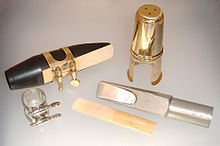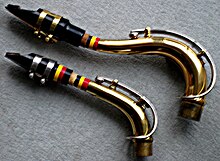saxophone
| saxophone | |
|---|---|
| engl .: saxophone , ital .: sassofono | |
| Alto saxophone | |
| classification |
Aerophonic woodwind instrument with single reed |
| range | b 0 to f sharp 3 (higher notes with special fingerings, tone see types) |
| Musician | |
|
List of saxophonists Category: Saxophonist |
|
The saxophone or saxophone is a musical instrument from the group of single reed instruments . The body of this wind instrument is a relatively wide ( wide-scaled ), strongly conical (widening significantly towards the end) sound tube from 64 to 293 cm in length. This means that all saxophone designs differ from the cylindrical clarinet, for example . The key system corresponds to that of the oboe . By definition, the saxophone belongs to the family of woodwind instruments , unlike its metallic body (mostly made of silver-plated, gold-plated or lacquered brass) , as its sound is generated with the help of a reed on the mouthpiece.
History and general
The instrument was invented as the "saxophone" by the Belgian Adolphe Sax (actually Antoine Joseph Sax) in 1840 and patented on March 21, 1846 under the number 3226 in France . In the patent application , Sax justified his invention with the lack of good sounding woodwind instruments in the lower register and with the invention of the saxophone wanted to create a woodwind instrument with a sound between the "warming, flexible" sound of the clarinet and the more penetrating, nasal sound of the oboe .
The first saxophone built by Adolphe Sax was a bass instrument in C. He designed the new instrument from the outset for voices from soprano to sub-double bass , alternating between fourths and fifths. He envisaged the C / F tuning for use in the symphony orchestra , while the B / E tuning was intended for military music . The C and F instruments are rarely manufactured today and never had the importance they should have had after their inventor. Only the C-Melody saxophone was built until the 1950s and was widely used in jazz , especially in swing .
In 1929, Henri Selmer took over the Paris workshop from Adolphe Sax and became the official holder of his patent rights. In 2010, Henri Selmer Paris celebrated the company's 125th anniversary. Saxophones by Henri Selmer Paris, especially the Mark VI, have now achieved cult status and are among the products with outstanding craftsmanship.
It was not until a long time after its invention that the emergence of jazz in New Orleans began the real triumphant advance of this instrument, with its very variable sound and large dynamic range. In 1929 Alfred Baresel called it “the most important melody instrument in jazz”.
Following its history, the saxophone was not created with jazz or was not designed for it at all, but was actually intended for classical "serious" concert music, in which it has never been able to assert itself (at least not to the extent in jazz) .
Contrary to popular belief, the saxophone is by no means an instrument that is only used in jazz. In fact, saxophones have been used in a myriad of genres of music since the 20th century, including pop, rock 'n' roll, electronic music, but also serial music, as well as numerous other genres. It is also one of the most popular solo instruments in concert and dance music , and many well-known saxophone soloists have formed their own bands or combos .
In the German Empire , the saxophone was fought against as an instrument of degenerate music or negro music at the time of National Socialism and sometimes even before . The Deutsche Tonkünstler-Zeitung , for example, called for the instrument to be banned as early as 1929, which largely resulted from the successive ban on jazz music, the main field of application of the saxophone, from 1933 onwards. However, manufacturers threatened their existence turned to the Reich Ministry of Economics , which received information from the Reich Ministry for Public Enlightenment and Propaganda that "the saxophone is completely innocent of Negro music", since the "invention of Adolf Sax [...] mainly in of military music . As with all other instruments, you can also make good music with the saxophone. ”The Deutsche Kultur-Wacht wrote in 1933:“ If it is played correctly, without the usual antics ( glissando etc.), it proves to be a valuable aid for Dance music . ”So the saxophone continued to be used in both dance and military music. The Band of the German Air Force contained from 1940 comprehensive a five instruments saxophone set. Hans Hinkel renewed the opinion of the Propaganda Ministry in 1942 by stating that the saxophone was only “wrongly called a Negro instrument”. At the same time, the speaker for music in the Reich Aviation Ministry praised the enrichment of the orchestra "with a typical timbre" and the "[considerable] tonal possibilities of expression".
Many Nazi ideologues (e.g. Herbert Gerigk , Alfred Rosenberg ) still did not see the saxophone as capable of "good music" because of its sound and its use in Negro music.
Structure and designs
In the case of the saxophone, the sound is created by a single vibrating reed (as e.g. also with the clarinet ). That is why the saxophone belongs to the woodwind instruments and not, as the body material would suggest, to the brass instruments .
The saxophone can be dismantled into three parts:
- Mouthpiece with reed and ligature (ligature)
- S-bow
- Body
The sopranino and soprillo and some soprano saxophones only consist of a body and mouthpiece.
When playing, the instrument is usually attached to a strap that the player hangs around his neck. For larger instruments (from baritone saxophone and larger) as well as for smaller saxophonists, there are also back or shoulder straps. Due to their greater comfort, these have recently become more popular with tenor saxophonists, but severely limit their mobility and playing dynamics. Soprano saxophone and sopranino saxophone are often played without a strap. Bass saxophones and larger ones are mostly played in a stand and seated because they are too heavy for a bare strap.
Unlike the clarinet, the saxophone does not blow into the duodecime , but (like the flute and oboe ) into the octave . This is caused by the conical shape of the sound tube (close to the mouthpiece and very far from the bell). For overblowing, there is an octave or overblowing key on the back (operated with the thumb), which in today's standard designs automatically opens one of two small tone holes depending on the note played. In terms of fingering, the instrument is largely related to the Bb clarinet and partly also to the modern flute.
Alto saxophone and tenor saxophone are most frequently used , followed by soprano saxophones and baritone saxophones and then the bass saxophone, while the variants in the extreme registers are used less often - solo or to enrich the timbres in larger ensembles. The alto saxophone is the most popular not least because its size, price and weight make it suitable as a beginner's instrument for children and young people. In addition, the high notes do not require an overly strong approach and the low notes do not require too much air.
| Design | abbreviation | Mood | notated c 1 sounds as | sounding range |
|---|---|---|---|---|
| Soprillo | B. | b 1 | as 1 - d 4 | |
| Sopranino | sss, ssi | |||
| It | it 1 | des 1 - as 3 | ||
| C soprano | C. | c 1 | b 0 - f 3 | |
| soprano | ss, sop | B. | b 0 | as 0 - es 3 (e 3 ) |
| Mezzo-soprano | F. | f 0 | es 0 - b 2 | |
| Old | as, alto, asx | It | it 0 | des 0 - as 2 (a 2 ) |
| C-Melody | c-mel, cmel | C. | c 0 | B - f 2 |
| tenor | ts | B. | B. | Ace - es 2 (e 2 ) |
| baritone | bar, bars, bs | It | It | (C) Des - a 1 |
| bass | bsx, bassax, b-sax, bsax, bss, basssax |
B. | B 1 | (G 1 ) As 1 - e 1 |
| double bass | cbsx, cb-sax | It | It 1 | (C 1 ) Des 1 - a 0 |
| Sub-double bass | B. | B 2 | As 2 - e 0 |
- Other designs
Since the beginning of this millennium there has been an even smaller saxophone than the Sopranino: the Soprillo in Bb tuning in a straight design with applique up to the high e, with normal fingering. A special feature is the upper octave key that is built into the mouthpiece. The sound tube of the Soprillo has a length of 30 cm.
Since around the same time there have also been very playable double bass and sub-double bass saxophones. Their design differs slightly from the classic shape: the main tube is bent again. This makes these instruments more compact. In a modernized design, called Tubax , double bass and sub-double bass saxophones are manufactured in Germany by Benedikt Eppelsheim . Both have smaller mouthpieces (baritone or bass saxophone mouthpiece), which improve response, and a narrower scale , which means that less air is used and longer notes can be played.
The agility and versatility of the saxophone led to numerous experiments. The Conn-O-Sax (1928) was dissolved in a straight shape with a bulbous bell built. The straight shape of the saxophone gives the instrument an oboe-like sound. When Conn-O-Sax the nasal sound a double-reed instrument (by the spherical bell oboe , English horn or bassoon ) is reached. The F tuning of this instrument is similar to that of the cor anglais, i.e. it is a whole tone higher than that of the alto saxophone in E flat and thus corresponds to Sax's original intention to build an instrument suitable for a symphony orchestra. Although its advantages outweigh the cor anglais, the instrument has not caught on.
The Saxello is a Bb soprano saxophone with a bent back head and a tip bent forward. It was manufactured by the King HN White Company ( King Saxello ) from around 1924 , but production ceased in the 1930s during the Great Depression . Today, however, Saxellos are being produced again. They became known u. a. by the jazz musician Rahsaan Roland Kirk , who also played on the similar Manzello . He also played a modified Buescher alto saxophone called Stritch .
Another development was to build saxophones out of wood in order to achieve a softer sound. However, these forms are difficult to manufacture in terms of instrument construction and have severe intonation problems. The wooden saxophone is very similar to the clarinet and the Hungarian tárogató .
In the 1950s the Grafton company built a small series of plastic saxophones made famous by Ornette Coleman and Charlie Parker. The concept of the plastic saxophone was revived with the appearance of the first vibrato sax from the Thai company Vibrato since 2010.
Various new approaches were also pursued with regard to the technology for covering the tone holes . The rule is still today the use of hollow metal flaps, which are filled with a felt pad covered with leather. In the course of technical development, the material of these cushions has also been replaced by modern plastic materials (Codera, TopTone or Jim Schmidt (USA)), but the padded flap is still standard today. In order to improve the resonance behavior, various metal or plastic supports (so-called resonators) are used on the larger flaps, which are riveted onto the pad or, in the case of the Buescher snap-in pad, can also be screwed in. Today as then, leather-covered upholstery is built into 99% of all saxophones.
An exception was a saxophone temporarily produced by Selmer USA in the period from 1938 to 1941 : In cooperation with the then renowned US manufacturer Buescher, a saxophone without key pads ("a padless saxophone") was developed with the seal of the tone holes by a leather ring on the tone hole itself and the use of absolutely flat-ground brass keys. Although the resonance behavior and response of the model were described as very good, the thin sealing rings were too fragile in the long run, so that the system soon disappeared from the market.
The aforementioned Vibratosax plastic saxophone has a special form of key pad: the pads are made entirely of flexible silicone and are suspended from a relatively small point that is only a few millimeters in diameter and can be moved around directly on the lever. This means that the keys are completely self-leveling, which ensures that the tone holes are always closed in the best possible way, and accordingly noticeably reduces maintenance costs compared to traditional tone hole covers.
The pocket saxophone can be regarded as a form of the saxophone because of its name and its sound, but not because of the characteristic instrument properties. It is more like something in the middle between clarinet and flute.
Playing technique
The mouthpiece is placed in the mouth so that the upper incisors are in front of the inclined surface. With the classic (closed) approach , as with the clarinet, the lower lip is pulled inwards slightly over the lower teeth and pressed against the reed. In contrast, in the modern (open) approach, the lower lip is arched outwards. The teeth must not touch the leaf. With this approach, a harder timbre is achieved. For Blade easier appeals it is humidified before playing from both sides.
The left hand mainly operates the upper keys of the saxophone. The thumb of this hand rests on the provided thumb plate and thus holds the upper part of the body. If necessary, it pushes to the blowing-over to facilitate the octave key located directly over it. The right hand mainly operates the lower flaps. With the right thumb, the player holds the instrument in the middle by gently pushing it away on the thumb grip. It has a flap each for the index, middle and ring fingers of the right and left hand. The index finger of the upper hand also operates the small B key and the flageolet key. The little fingers of the right and left hand operate two or four flaps, which are connected to rollers to make changing flaps easier.
Fingering tables exist for both the normal pitch and the altissimo area.
Saxophone music
The first saxophone movements of the early swing orchestras in the late 1920s consisted of two alto saxophones and one tenor saxophone (e.g. Fletcher Henderson ). With the size of the orchestra, the number of saxophones also increased, initially to four musicians (two alto saxophones, two tenor saxophones) and then to five as the standard line-up for the big bands of the 1940s with two alto saxophones, two tenor saxophones and one baritone saxophone. Since then, this formation has been considered the usual big band line-up, although there have always been different compositions with a special sound. Examples of this are the “Four Brothers line-up” by Woody Herman with three tenor and one baritone saxophone or the saxophone setting by Glenn Miller, led by a clarinet . In the 1950s, the saxophone sound of Billy Vaughn became popular, in which the (two-part) melody was carried out by two alto saxophones in the high register. Usually, the saxophones in a saxophone setting are set in parallel with several voices, with the first alto saxophone being responsible for the melody, while the baritone saxophone fills the bass lines. A bass saxophone rarely appears in an orchestral line-up, but as a rule not as a member of the saxophone set, but as a replacement for the tuba or double bass.
If saxophones are used in music combos, it is often a tenor saxophone (typical for the line-up of a rock 'n' roll combo) or an alto saxophone (now and then in rock music). If a three-part brass section is used in a pop or rock music combo, it usually consists of a saxophone (alto or tenor) together with a trumpet and a trombone . In larger (brass) bands of the more popular type, saxophones (alto and tenor) often appear in the secondary voices (together with tenor horns ).
Wind band
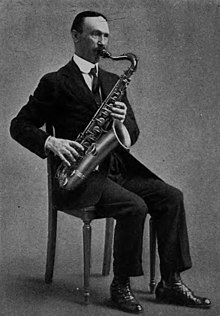
The saxophone has the longest tradition in the wind band. There the saxophone has an important tonal meaning. It connects the woodwind register with the brass register brass instruments . On the one hand the saxophone has the mobility of a woodwind instrument, on the other hand it is hardly inferior to the volume of a brass instrument. In 1844 Berlioz predicted a great future for the saxophone due to its properties.
Classical music
In classical music, the saxophone is mainly used as a solo instrument, in saxophone formations (especially the saxophone quartet) and in chamber music ensembles. It is less common in the symphony orchestra. Although the first types of saxophone emerged in the 19th century, it was only used more and more in classical art music from the beginning of the 20th century. One of the best-known, rare examples from the (later) 19th century is Georges Bizet's L'Arlésienne . Well-known examples from the 20th century include: a. George Gershwin's Rhapsody in Blue and an American in Paris , Maurice Ravel's Boléro , Alban Berg's Violin Concerto and Lulu or the Sinfonia domestica by Richard Strauss . The instrument is usually required as a secondary instrument by one of the clarinetists. One of the earliest saxophone concerts is Alexander Konstantinowitsch Glasunow's Alto Saxophone Concerto in E flat major, Op. 109 (first performed in 1934). The rhapsody for alto saxophone and orchestra by Claude Debussy was composed earlier, but only premiered posthumously . Furthermore, u. a. the GDR - Sinfoniker Max Butting a preference for the sound of the instrument and used it in most of his orchestral works. Recently, u. a. Luciano Berio , Pierre Boulez or Péter Eötvös play the saxophone in the orchestra; meanwhile it is by no means a rare guest in contemporary orchestral literature.
Saxophone solo
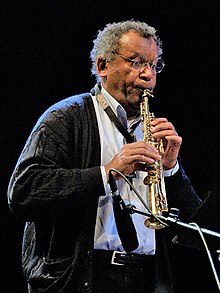
The saxophone is used as a solo instrument, especially in new music . In their compositions, the composers particularly emphasize the avant-garde sound possibilities and the technical aspects of the saxophone: multiphonics , flageolet techniques , key noises, glissando , tremolo and many more.
Some of the composers who have written works for saxophone solo are: Eckart Beinke , Paul Bonneau , Pierre-Max Dubois , Anders Eliasson , Jean Françaix , Alexander Konstantinowitsch Glasunow (who, however, belongs to the 19th century), Jacques Ibert , Paul Hindemith , Nicolaus A.Huber, Christian Lauba , Fabien Lévy , Jean-Marie Londeix , Ryō Noda , Martin Christoph Redel , Guido Rennert , Bertold Hummel , Fuminori Tanada , Pierre-Max Dubois, Jean Rivier , Sigfrid Karg-Elert or Patrice Sciortino .
A series of works for his instrument and orchestra are dedicated to the American alto saxophonist John-Edward Kelly . Anders Eliasson wrote his five-movement Sinfonia concertante: Symphony No. 3 for alto saxophone and orchestra (1989; a version for soprano saxophone was created in 2010), Pehr Henrik Nordgren Phantasme (1992) and Jan Sandström My Assam Dragon (1996) for Kelly. The concerto for strings and alto saxophone (2003, version for soprano saxophone 2009) by Anders Eliasson and the Chamber Symphony No. 3 for 20 strings and alto saxophone (1996/97) by Kalevi Aho , who wrote a concerto for the Raschèr Saxophone Quartet for Saxophone Quartet, Bells and Strings (entitled Kellot / Glocken ) wrote.
At the request of the Swedish saxophonist Anders Paulsson , Anders Eliasson wrote versions of his Sinfonia concertante in 2009 and 2010 : 3rd Symphony for alto saxophone and orchestra and the concerto for strings and alto saxophone for soprano saxophone. Friedrich Cerha also wrote for the soprano saxophone . His concerto for soprano saxophone and orchestra was premiered in 2004.
Recently there is even a concert for baritone saxophone and orchestra by Georg Friedrich Haas , which was premiered on May 3rd, 2008 by the WDR Symphony Orchestra Cologne under the direction of Emilio Pomarico (live broadcast on the radio). Marcus Weiss was the soloist.
In 2009 Timo Jouko Herrmann wrote a concert piece with a large orchestra alluding to the poem Morphine by Heinrich Heine for saxophonist Dieter Kraus , in which the soloist constantly switches between soprano and alto saxophone.
Saxophone in chamber music line-up
In the chamber music line-up, the saxophone is used in combination with other solo instruments. Some of the combinations that are used in compositions combine the saxophone with vocals , violin , flute , clarinet , oboe , bassoon , trumpet , trombone or drums, among others . The saxophone is particularly often used as the main instrument with accompaniment. The combination of saxophone and piano is particularly widespread here , but there are also pieces accompanied by organ , accordion , harp , double bass and guitar .
Saxophone formations
The formations in which the saxophone is used in classical music are based on the formations of string instruments. In particular, the saxophone is played in the saxophone quartet and in larger saxophone ensembles. The standard line-up of the saxophone quartet is soprano, alto, tenor and baritone. Important classical saxophone quartets include a. the Raschèr Saxophone Quartet , the Aurelia Saxophone Quartet , the Sonic.art Saxophone Quartet or the Pindakaas Saxophone Quartet . In the saxophone quintet, the most common instrumentation is soprano, alto 1, alto 2, tenor and baritone. The line-up of the larger saxophone ensembles varies depending on the ensemble leader and composition. The standard composition of the saxophone ensemble introduced by Jean-Marie Londeix consists of a sopranino, two soprano, three alto, three tenor, two baritone and one bass saxophone. In addition to the chamber music Londeix line-up with twelve independently led voices, one encounters saxophone orchestra formations, which (similar to the string orchestra or trombone choir ) make up the voices several times (saxophone choir), but start from fewer voices, e.g. B. a five-part set SAAT B. Others, especially smaller saxophone ensembles , such as the Rova Saxophone Quartet , change the composition of the instruments depending on the composition. The six common types of saxophones are also used here.
jazz
Jazz has been saxophonized since the swing era. There was and is hardly a jazz ensemble in which the saxophone would not at least play an important solo role. The most common is a quartet , i.e. rhythm section plus saxophone. Derived from this, one must see the trio line-ups in which the harmony instrument, i.e. guitar or piano , is omitted.
Pure saxophone ensembles are rarer, but not only play an interesting role in border areas of jazz due to the almost unlimited sound possibilities, such as the World Saxophone Quartet or the Cologne Saxophone Mafia as two very long-lasting ensembles. Saxophones are also important in a big band , here they are usually composed as follows: first and second alto saxophone, first and second tenor saxophone and a baritone saxophone.
In order to be able to achieve an individual timbre in jazz, the choice of equipment, i.e. the accessories, is decisive in addition to the actual instrument. Not only the material of the mouthpiece (mostly metal or ebonite ) and its shape, but also the type of ligature influence the timbre. It is not uncommon for mouthpieces to be subsequently adjusted in shape ("refaced").
Popular music
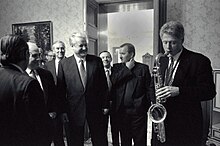
A "roaring" saxophone played a major role in classic rock 'n' roll , especially in the twist . It was particularly popular in black American music, soul and blues . Also in Jamaican Ska , similar to soul and dancehall music of the late fifties and early sixties, the wind sections could not be missing. It was rarely used here as a solo instrument. In rock music , especially in New Wave and the revived two-tone ska of the 1980s, the saxophone was also particularly popular as a solo instrument and as a section instrument, and it was a downright fashionable instrument.
See also
literature
- Eugen Brixel : The clarinet and the saxophone (= series for young musicians. Issue 1). Music publisher Stefan Reischel, Oberneunkirchen, Austria, 1983.
- Bernhard Habla: solo saxophone and wind orchestra. Directory of over 350 solo works for one or more saxophones and wind orchestra (= works for solo instrument with wind orchestra. Volume 5). Vienna 1996.
- Matthias Hochheim: Saxwelt, the German saxophone book. Books on Demand, 2004, ISBN 3-8334-2187-8 (detailed lists of serial numbers, Das C-Melody, The history of the saxophone and its manufacturer).
- Jaap Kool : The saxophone. JJ Weber, Leipzig 1931. New edition: Bochinsky, Frankfurt am Main 1989, ISBN 3-923639-81-3 .
- Uwe Ladwig: Saxophones. buchwerft-verlag.de, Kiel 2011, ISBN 978-3-86342-280-6 .
- Jean-Marie Londeix: 150 ans de musique pour saxophone. Roncorp Publications, USA 1995. (This thick, expensive book lists the worldwide total of compositions that were ever composed for at least one saxophone between 1844 and 1994, including educational reading, chamber music, ensemble and concerts, equal and mixed ensembles.)
- Patrick Murphy: Extended Techniques for Saxophone. An Approach Through Musical Examples. (Dissertation) Arizona State University, 2013
- Peter Ninaus: Requirements for wind lessons using the example of the clarinet. A consideration under the aspects of music education, psychology, physiology and instrument making . Bachelor thesis at the University of Music and Performing Arts in Graz, 2004.
- Karl Ventzke, Claus Raumberger, Dietrich Hilkenbach: The saxophones. Contributions to their building characteristics, function and history 4th edition, Erwin Bochinsky, Frankfurt 2001, ISBN 3-923639-45-7 .
Web links
- Literature on the subject of the saxophone in the catalog of the German National Library
- Making a saxophone
- Acoustic saxophone (English)
- Hans-Jürgen Schaal : Like the plaintive howling of the wind - About the saxophone in classical music. . In: hjs-jazz.de , 1997.
Individual evidence
- ↑ Illustration of the patent from 1846. In: selmer.fr . Retrieved April 9, 2018.
- ↑ a b c Hans-Jürgen Schaal : "A typical jazz instrument" - the saxophone in National Socialism. In: hjs-jazz.de. 2011, accessed April 9, 2018 .
- ↑ Lieutenant Colonel Winter: The Music of the Air Force . In: Hermann Matzke (Hrsg.): Zeitschrift für Instrumentenbau . 63rd year, no. 5/6 . Breslau 1942, p. 26–27 , here p. 27 , urn : nbn: de: bvb: 12-bsb00004289-0 .
- ↑ www.jazzindex.ch
- ^ Rampone and Cazzani Saxello , King HN White Saxello . Historic King Saxellos are traded at high prices.
- ^ Nicholas Gebhardt: Going for Jazz: Musical Practices and American Ideology . University of Chicago Press, July 15, 2001, ISBN 978-0-226-28467-5 , pp. 158, 159.
- ↑ Michael Segell: The Devil's Horn: The Story of the Saxophone, from Noisy Novelty to King of Cool . Farrar, Straus and Giroux, October 15, 2005, ISBN 978-1-4299-3087-1 , p. 193.
- ↑ The ultimate fingering chart for saxophones .
- ↑ Albert Loritz: What to do with the many saxophonists? In: Neue Musikzeitung. February 2011, accessed April 9, 2018 .

